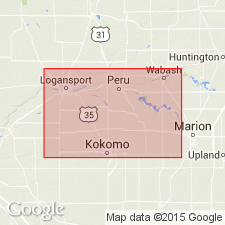
- Usage in publication:
-
- Kenneth limestone
- Modifications:
-
- Named
- Dominant lithology:
-
- Limestone
- Chert
- AAPG geologic province:
-
- Cincinnati arch
Summary:
Name Kenneth limestone applied to very cherty limestone, from 1 to 20 ft thick in outcrops, resting on Kokomo limestone of Foerste with possible unconformity. Top of formation not known. Exposed in quarries at Kenneth Station and vicinity, Cass Co., north-central IN.
Source: GNU records (USGS DDS-6; Reston GNULEX).
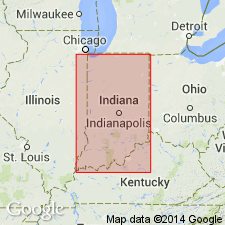
- Usage in publication:
-
- Kenneth limestone
- Modifications:
-
- Overview
- AAPG geologic province:
-
- Cincinnati arch
Summary:
Kenneth limestone is upper part (brachiopod-bearing beds) of Kokomo limestone of Foerste (1904). Thickness a few ft at Kokomo to over 35 ft near type section. Fossils listed. Fauna has Cayugan affinities but much work is needed to establish its correlation.
Source: GNU records (USGS DDS-6; Reston GNULEX).
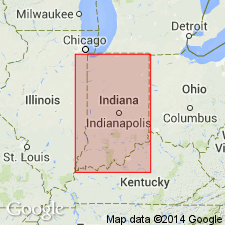
- Usage in publication:
-
- Kenneth limestone
- Modifications:
-
- Age modified
- AAPG geologic province:
-
- Cincinnati arch
Summary:
Kenneth limestone described as gray to tan dense cherty and irregularly bedded limestone 30 to 40 ft thick. Overlies Kokomo limestone; underlies Pendleton sandstone. Age is Early Devonian.
Source: GNU records (USGS DDS-6; Reston GNULEX).

- Usage in publication:
-
- Kenneth Limestone Member
- Modifications:
-
- Revised
- AAPG geologic province:
-
- Cincinnati arch
Summary:
Kenneth reduced in rank to member of Salina Formation. Age in this report given as Silurian.
Source: GNU records (USGS DDS-6; Reston GNULEX).
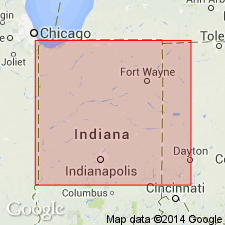
- Usage in publication:
-
- Kenneth Limestone Member
- Modifications:
-
- Revised
- AAPG geologic province:
-
- Cincinnati arch
Summary:
Kenneth Limestone Member here assigned to Wabash Formation of Salina Group. Overlies Kokomo Limestone Member of Wabash and unconformably underlies unnamed Middle Devonian to Quaternary rocks. Age is Late Silurian.
Source: GNU records (USGS DDS-6; Reston GNULEX).
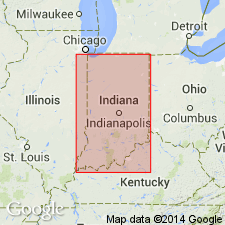
- Usage in publication:
-
- Kenneth Limestone Member
- Modifications:
-
- Overview
- AAPG geologic province:
-
- Cincinnati arch
Summary:
The Kenneth Limestone Member of the Wabash Formation is light-colored dense to fine-grained bedded to massive cherty limestone that is typically exposed in an abandoned France Stone Co. quarry near Kenneth. According to Pinsak and Shaver, the Kenneth type section is in the large composite quarry in the center of sec. 30, T27N, R1E. Some question remains as to the actual type section designated by Cumings and Shrock, as in 1928, they also mentioned quarrying in the adjoining section (sec. 25, T27N, R1W). The unit appears to be coarsely mottled in places and in some other places consists of whitish to pinkish granular limestone that commonly is abundantly fossiliferous. This facies includes coquinas of brachiopods and ranges to reef-framework rock with abundant coral. The Kenneth has very limited distribution. Its basic character as cherty dolomitic limestone and its high stratigraphic position hardly distinguish the Kenneth from the similar Liston Creek. It is distinguished only where Silurian rocks of its type are underlain by the distinctively laminated Kokomo Member. The upper Kenneth contact everywhere coincides with the pre-Middle Devonian unconformity. It is now known only in Cass, Miami, and Carroll Cos. It ranges in thickness from an erosional zero to an average of 25 to 30 ft and attains a maximum of about 45 ft. Within the Wabash, the Kenneth correlates with the upper part of the Liston Creek and with the upper part of the Bailey Limestone of the Illinois basin. Conodont and ostracod evidence indicates a very late Silurian age.
Source: GNU records (USGS DDS-6; Reston GNULEX).
For more information, please contact Nancy Stamm, Geologic Names Committee Secretary.
Asterisk (*) indicates published by U.S. Geological Survey authors.
"No current usage" (†) implies that a name has been abandoned or has fallen into disuse. Former usage and, if known, replacement name given in parentheses ( ).
Slash (/) indicates name conflicts with nomenclatural guidelines (CSN, 1933; ACSN, 1961, 1970; NACSN, 1983, 2005, 2021). May be explained within brackets ([ ]).

